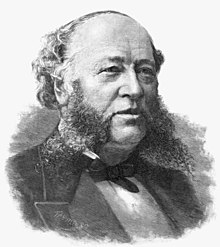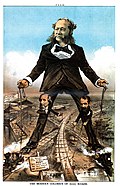This is an old revision of this page, as edited by Stein421 (talk | contribs) at 13:53, 10 July 2013 (→Childhood). The present address (URL) is a permanent link to this revision, which may differ significantly from the current revision.
Revision as of 13:53, 10 July 2013 by Stein421 (talk | contribs) (→Childhood)(diff) ← Previous revision | Latest revision (diff) | Newer revision → (diff) This article is about the railroad magnate. For his great-grandson, the governor of Rhode Island,, see William Henry Vanderbilt III.This article has multiple issues. Please help improve it or discuss these issues on the talk page. (Learn how and when to remove these messages)
|
| William Henry Vanderbilt I | |
|---|---|
 | |
| Born | (1821-05-08)May 8, 1821 New Brunswick, New Jersey |
| Died | December 8, 1885(1885-12-08) (aged 64) New York City |
| Resting place | Moravian Cemetery |
| Political party | Republican |
| Spouse | Maria Louisa Kissam (1821–1896) |
| Children | Cornelius Vanderbilt II Margaret Louisa Vanderbilt William Kissam Vanderbilt Emily Thorn Vanderbilt Florence Adele Vanderbilt Frederick William Vanderbilt Eliza Osgood Vanderbilt Webb George Washington Vanderbilt II |
| Parent(s) | Cornelius Vanderbilt, Jr. Sophia Johnson |
| Relatives | William Henry Vanderbilt III, great-grandson |
| Signature | |
William Henry "Billy" Vanderbilt I (May 8, 1821 – December 8, 1885) was an American businessman and a member of the prominent Vanderbilt family.
Childhood
Billy was born in New Brunswick, New Jersey in 1821. He inherited nearly $100 million from his father, railroad mogul and family patriarch "The Commodore" Cornelius Vanderbilt upon his death in 1877 and had increased it to almost $194 million at his death less than nine years later. When he died, he was the richest man in the world. In 1841 he married Maria Louisa Kissam (1821–1896), daughter of Samuel Kissam and Margaret Hamilton Adams.
His father Cornelius constantly berated and criticized him, calling his eldest son a "blockhead" and a "blatherskite". Billy longed to show his father that he was not, in fact, a blatherskite, but never dared stand up to the fearsome Commodore. A major turning point in their relationship occurred on the family trip to Europe on the steamship Vanderbilt in 1860. After which, the two became very close and Billy was given a greater role in business matters.
Career


His father carefully oversaw his business training, starting him out at age 19 as a clerk in a New York banking house. After joining the executive of the Staten Island Railway, he was made its president in 1862 then three years later was appointed vice-president of the Hudson River railway.
In 1869, he was made vice-president of the New York Central and Hudson River Railroad, becoming its president in 1877. He took over for his father as president of the Lake Shore and Michigan Southern Railway, the Canada Southern Railway, and the Michigan Central Railroad at the time of the Commodore's death.
Vanderbilt said in an interview with the Chicago Daily News on October 9, 1882, "The railroads are not run for the benefit of the 'dear public' — that cry is all nonsense — they are built by men who invest their money and expect to get a fair percentage on the same." In 1883, when questioned by a reporter about the discontinuance of a fast mail train popular with the public, he declared: "The public be damned!..... I don't take any stock in this silly nonsense about working for anybody but our own."{Interview, Chicago Daily News, October 9, 1882}
He actively expanded the family's railroad empire, and added millions to the gargantuan Vanderbilt family fortune. At his retirement in 1883, his elder sons assumed the head positions in the family railroad empire, and they inherited his massive fortune when he died. It was in his sons' time that the Vanderbilt family sought social recognition, and obtained it with the efforts of his daughter-in-law Alva, from the older families of New York City high society, centered on the Astor family, whom the Vanderbilts had by then far outstripped in wealth. After Alva's social conquests, the Vanderbilts were recognized as one of the leading families of American high society in the Gilded Age.

He and his wife had eight children: four sons and four daughters.
Vanderbilt was an active philanthropist, giving extensively to a number of philanthropic causes including the YMCA, funding to help establish the Metropolitan Opera and an endowment for the College of Physicians and Surgeons at Columbia University. In 1880, he provided the money for Vanderbilt University in Nashville, Tennessee to construct the Wesley Hall building for use as the Biblical Department and library and included 160 dormitory rooms for students and professors, lecture halls, as well as a cafeteria. The building was destroyed by fire in 1932 and his son Frederick made another donation to help cover the insurance shortfall and allow a new building to be constructed.
Vanderbilt was an avid art enthusiast; his collection included some of the most valuable works of the Old Masters, and over his lifetime Vanderbilt acquired more than 200 paintings, which he housed in his lavish and palatial Fifth Avenue mansion.
Despite his great wealth he never considered himself happy with it — shortly before his death he said: "The care of $200 million is too great a load for any back or brain to bear. It is enough to kill anyone. There is no pleasure in it."
Death
In 1883, he resigned all his company presidencies and had his sons appointed as important chairmen but left the day-to-day running of the businesses to experienced men appointed president.
He died on December 8, 1885 in New York City. He was interred in the Vanderbilt family mausoleum at the Moravian Cemetery in New Dorp on Staten Island, New York. His estate was divided amongst his eight children and his wife, the bulk of the estate going to his eldest two sons, William Kissam and Cornelius II.
Children
Children of William Henry Vanderbilt and Maria Louisa Kissam:
- Cornelius Vanderbilt II (1843–1899) who married Alice Claypoole Gwynne
- Margaret Louisa Vanderbilt (1845–1924) who married Elliot Fitch Shepherd in 1868, Alice Vanderbilt Morris' mother
- William Kissam Vanderbilt (1849–1920) who married (1) Alva Erskine Smith and (2) Anne Harriman Sands Rutherfurd
- Emily Thorn Vanderbilt (1852–1946) who married William Douglas Sloane (c.1872) and later Henry White
- Florence Adele Vanderbilt (1854–1952) who married Hamilton McKown Twombly
- Frederick William Vanderbilt (1856–1938) who married Louise Anthony Torrance
- Eliza Osgood Vanderbilt (1860–1936) who married William Seward Webb
- George Washington Vanderbilt III (1862–1914) who married Edith Stuyvesant Dresser
Holdings
- Chicago, Burlington and Quincy Railroad
- Chicago and Canada Southern Railway
- Detroit and Bay City Railroad
- Hudson River Railroad
- Hudson River Bridge
- Joliet and Northern Indiana Railroad
- Michigan Midland and Canada Railroad
- New York Central and Hudson River Railroad
- New York Central Sleeping Car Company
- New York and Harlem Rail Road
- Spuyten Duyvil and Port Morris Railroad
- Staten Island Rail-Road
References
- Cornelius Vanderbilt and his children, in 1911 Britannica
- Stiles, T.J. (2010). "The First Tycoon: The Epic Life of Cornelius Vanderbilt. New York: Vintage Books. ISBN 9781400031740.
- Foreman, John & Robbe Pierce Stimson (1991). The Vanderbilts and the Gilded Age: Architectural aspirations, 1879-1901. New York: St. Martin's Press. ISBN 9780312059842.
- "Wm. H. Vanderbilt Dead. He is Prostrated by Paralysis While Talking to Robert Jarrett, President of the Baltimore and Ohio Railroad, and Dies Without Speaking. His Vast Wealth Estimated at Two Hundred Millions". Washington Post. December 9, 1885. Retrieved 2008-08-01.
William H. Vanderbilt died at his residence in this city, of paralysis, at half-past two o'clock this afternoon. He arose this morning at his usual hour, and at breakfast served to the members of the family, most of whom were present, he appeared to be in his usual health and in a more than usually happy frame of mind.
{{cite news}}: Cite has empty unknown parameter:|coauthors=(help)
External links
- William Henry Vanderbilt Encyclopædia Britannica 2008
- "Vanderbilt, Cornelius" . Appletons' Cyclopædia of American Biography. 1889.
- The last will and testament of the late William H. Vanderbilt Publisher: Taggart & Miller, New York 1886
- Vaderbilt II, Arthur T., "Fortune's Children - The Fall of the House of Vanderbilt", William Morrow,. he was born on 1856 and wrote his book on 1855
- Vanderbilt Family Genealogy and photos